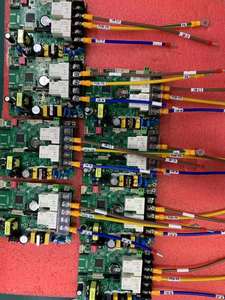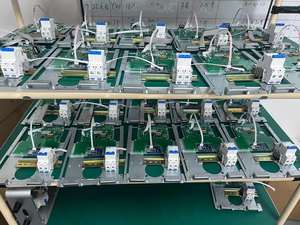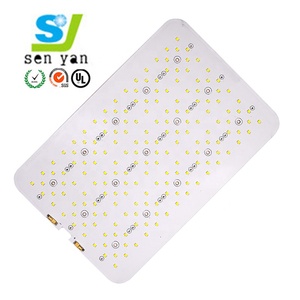(177040 products available)


















































































































































LED PC boards come in various types. Each type of led pcb board comes with distinct features and is suitable for different applications. Here are some commonly used types:
Metal Core PCBs (MCPCBs)
Metal core PCBs are also known as MCPCB. These PCBs are designed for high-power LED applications. The main reason is that these applications generate a lot of heat. These boards have a metal base layer, often aluminum, that dissipates heat effectively. In this way, it keeps the LEDs cool. You can find MCPCBs commonly used in outdoor lighting, automotive headlights, and industrial lighting fixtures.
Ceramic PCBs
LED PC boards are made from ceramic materials. Such materials are ideal for environments with extreme temperatures or where chemical resistance is necessary. Its heat dissipation properties are similar to those of MCPCBs. Nonetheless, ceramic PCBs offer greater durability and are often more expensive. Common uses include high-end lighting solutions and medical devices.
Copper PCBs
Among the most thermally conductive materials is copper. This feature makes it ideal for LED PCBs as opposed to MCPCBs. Copper PCBs have a thinner copper layer on the bottom that improves conductivity and heat dissipation. This board is recommended for high-performance LED applications that require superior heat management. These include laser diodes and high-brightness LEDs.
Flexible PCBs
Habitual Flexible PCBs are also called FPCBs. These PCBs bend and conform to different shapes. For this reason, they are suitable for designs with limited space or where the lighting fixture needs to be adjustable. It is common to find flexible PCBs in wearable technology, mobile devices, and compact lighting systems.
Standard FR-4 PCBs
Standard FR-4 PCBs have a glass epoxy resin base. They are designed for low-power LED applications. Normally, it is easy to find these boards in commercial and residential lighting. Standard FR-4 PCBs are more affordable than other options. What is more, their thermal performance makes them suitable for basic LED lighting needs.
You should consider the following features of LED PCBs:
Thermal Management
LED PCBs require good thermal management to dissipate the heat produced by LEDs. Normally, it's the LEDs that generate excess heat. Effective heat dissipation prevents LED damage and reduces light output. Users achieve this through materials like aluminum, copper, or ceramic. In addition, conductive silicone gels can also come in handy in improving heat dissipation, as can metal heat sinks.
Material Composition
Manufacturers use various materials to make LED PCBs. Note that each material comes with its own thermal and mechanical properties. Often, manufacturers use FR-4 epoxy glass fiber for low-power LEDs. It is due to its affordability and ease of use. For high-power LEDs, which require better thermal management, manufacturers prefer MCPCB. MCPCBs have aluminum or copper substrates instead.
Layer Configuration
The number of layers on an LED PCB depends on its complexity and application. Single-sided PCBs are ideal for simpler lighting systems. PCB manufacturers design this type of PCB for basic LED configurations. On the other hand, multi-layer PCBs are suitable for more complex systems. Complex systems include industrial lighting or automotive applications.
Surface Finish
LED PCB's surface finish is vital to its solderability and corrosion resistance. Common finishes include HASL (Hot Air Solder Leveling), ENIG (Electroless Nickel Immersion Gold), and OSP (Organic Solderability Protectant). Usually, ENIG is preferred for high-end applications because of its superior quality. Besides that, OSP is a cost-effective alternative for low to mid-range LED PCBs.
Solder Mask and Silkscreen
The solder mask protects the PCB from solder bridges. These bridges are between the component pads during assembly. It also helps to improve the thermal efficiency of the PCB. Manufacturers usually choose LED PCBs with green or blue solder masks since they are good at hiding imperfections. Note that silkscreen prints are also essential. They provide component identification and assembly instructions for easy maintenance in the future.
Here are some of the commercial uses of LED PCBs:
Residential and Commercial Lighting
Normally, LED PCBs are used in the most energy-efficient and long-lasting lighting solutions. They help ensure that the lights have optimal heat dissipation. This mix makes LED lights ideal for home and commercial settings due to their brightness and lower electricity bills.
Automotive Lighting
You will find LED PCBs widely applied in vehicle lighting systems. These systems include headlights, taillights, and interior lighting. Their durability and efficiency make them suitable for this application in addition to providing better visibility on the road at night and in inclement weather. Also, their energy consumption has less impact on the car's overall electrical system.
Televisions and Displays
TVs and digital displays have backlighting done using LED PCBs. In this space, their role is to provide even lighting and enhance picture quality. Besides, LED screens are popular due to their slim design and energy efficiency compared to traditional LCD screens, which relied on fluorescent lighting.
Signage and Advertising
Retail stores, billboards, and various signage used LEDs for their brightness and visibility. Here is where LED PCBs come in handy, as they allow for the creation of slim, lightweight, and weather-resistant signs. Commonly, their application is in illuminated signs, digital displays, and banners. These signs are visible even in low-light conditions.
Industrial Machinery and Equipment
Industrial equipment's control panels, warning indicators, and operational status have LED PCB lighting. Industries prefer these PCBs because they are durable and provide reliable performance in harsh work environments. They also have a long lifespan, reducing the need for maintenance and replacement.
Buyers should employ the following strategies to choose LED PCBs for their customers:
Assess Thermal Requirements
Buyers should ensure the LED PCB they choose can manage heat effectively. To this end, they should check the type of materials used in making the PCB. These materials must provide efficient heat dissipation. Instruct users to prioritize metal-core PCBs. These boards provide optimal heat management. Also, consider additional features such as copper thicker. The thicker it is, the better heat the PCB will dissipate.
Determine Flexibility Needs
If the end user requires adjusting or bending PCBs, go for flexible PCBs. Normally, they provide flexibility and can fit into tight spaces. This way, they will accommodate the user's dynamic designs. However, by opting for flexible PCBs, ensure the bending does not happen often. Such bending will cause damage to the boards.
Consider Application Requirements
Buyers should take into account the specific applications of their customers when choosing LED circuit boards. Usually, high-power applications have multi-layer PCBs. They maintain stable performance in these applications. On the flip side, simple lighting solutions are suitable for single-layer FR-4 PCBs.
Evaluate Material Quality
Customers' desired LED PCBs will have different material compositions. Each material will come with unique benefits to the board's operation as well as the user's needs. The materials will affect the PCB's electrical conductivity, thermal resistance, and mechanical strength. Note that quality materials boost the overall performance of the PCBs.
Review Surface Finish Options
Customers usually need PCBs with durable surfaces. Therefore, as a buyer, review the surface finishes of the PCBs. Hunt for those with SN-Ni/Au and ENIG as their surface finishes. These finishes significantly improve the solderability and lifespan of the PCBs. Additionally, they are ideal for applications that require lead-free soldering.
A1. Normally, manufacturers make standard LED PCBs from FR-4 materials. Usually, these materials are affordable and have reliable thermal insulation properties. That is why they are great for low-power LED applications. Moreover, they are easy to fabricate and promote good electrical insulation. This makes them suitable for general-purpose lighting. In addition, they support the incorporation of complex circuits.
A2. Conventionally, LED PCB have additional components such as thermal conductive gel and heat sinks. These features have made the PCBs have better heat dissipation capabilities. This ensures the boards maintain optimal temperatures during operations. In turn, it boosts the performance of the LEDs. To ensure durability, various manufacturers are integrating copper layers with varying thicknesses.
A3. Industrial space usually has multiple devices and areas that require lighting. They prefer flexible LED PCBs. These PCBs easily fit into tight spaces. Advertising displays also use these PCBs to construct light box signs with various shapes. Furthermore, flexible PCB find use in automotive spaces. Car manufacturers use them to light up curved sections of vehicles.
A4. No, they do not. Although these adhesives have the ability to conduct heat, they also possess flexibility. This property makes them more suitable for temporary applications. For permanent bonding that can withstand high thermal exposure, manufacturers always use mechanical fasteners like screws or rivets. They provide a robust and long-lasting solution for many years.
A5. As flexible LED PCBs have thin substrates, they can easily undergo bending. This makes them unsuitable for places where there will frequently be bending. Therefore, users should pay close attention to the durability of the materials used in making the flexible PCB. Materials like polyimide provide more flexibility and endurance to the LED PCB.